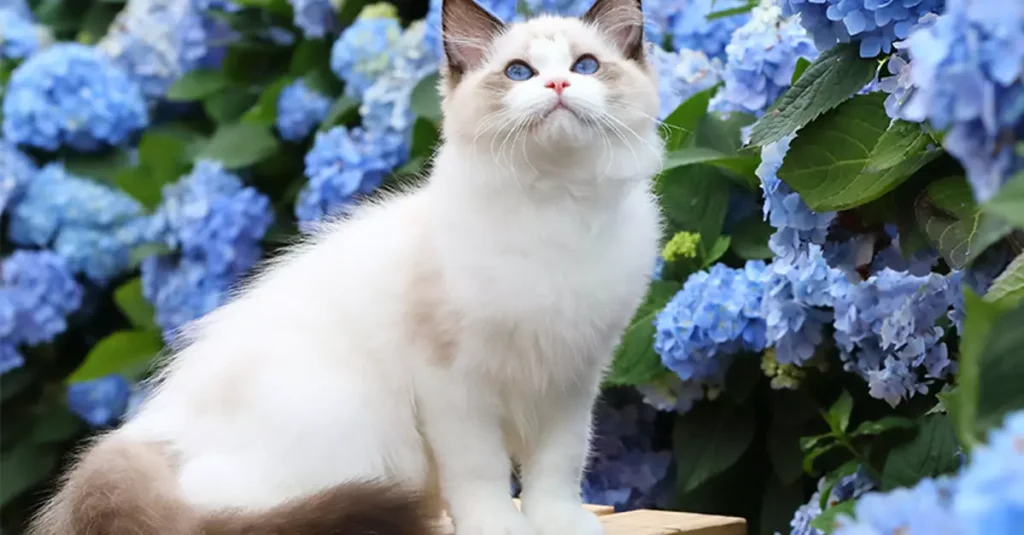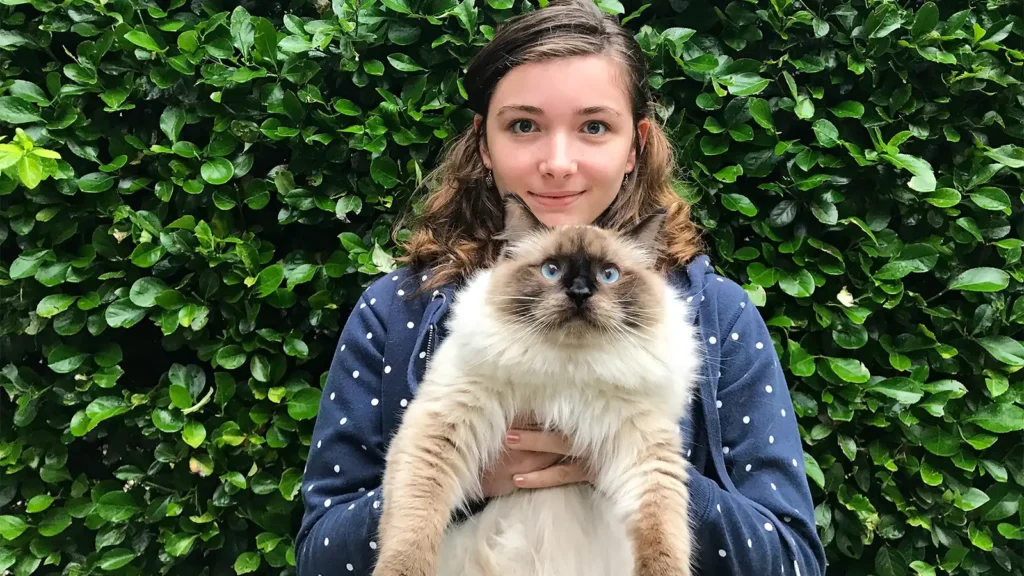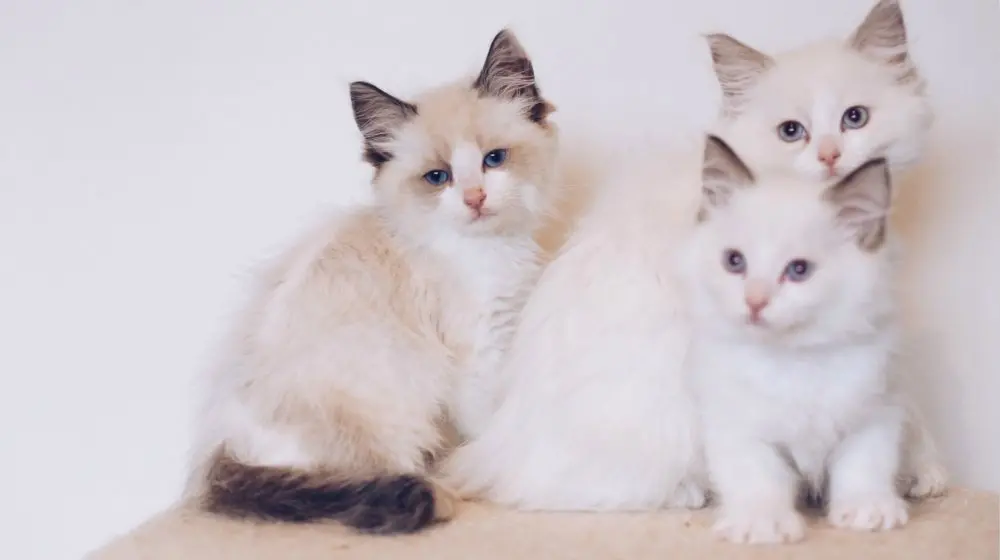The Ragdoll cat is a charming pet breed that is loved for its gentle personality and unique appearance. Whether acting coquettishly at home or showing off in competitions, Ragdoll cats have shown their unique charm and can be regarded as stars in the cat world. Due to the clingy nature of many Ragdoll cats, some people often say that their personalities are like dogs. This article will introduce the origin of the name of Ragdoll cats, their appearance, personality, common diseases, and how to take care of them, so that you can become a Ragdoll cat slave master!

💡The origin of the name of the Ragdoll cat
There are different stories about the origin of the name of Ragdoll cats. The most representative story is related to a cat named “Josephine”. It is said that the basis of Ann Baker’s Ragdoll cat breeding program is a female cat named Josephine. She is an extremely docile cat who will relax and lie on people and is very friendly to people. Close and unsuspecting. Anne named the cat “Ragdoll” to express its gentleness and softness like a Ragdoll.
Another explanation for the naming of Ragdoll cats comes from their soft, ragdoll-like physical characteristics and the meaning of the word “Ragdoll”. Ragdoll in English refers to the material used to fill the body when making ragdolls. Its softness and comfort are consistent with the characteristics of ragdoll cats.
In short, there may be different versions of the origin of the name of Ragdoll cats, but these stories all highlight the soft, docile and Ragdoll-like characteristics of Ragdoll cats.
💡The unique appearance of Ragdoll cats

Facial features
The eyes are usually blue, almost dark blue, the eyeballs are oval, and the head shape is round.
Body shape
Male cats are about 7 to 9 kilograms, and female cats are about 4 to 7 kilograms. They are medium to large in size. With their long hair, they usually look larger than ordinary cats. If you hold a ragdoll cat and it feels heavy, don’t think it is a fat cat. Its size can continue to grow up to 4 years old.
Pattern
Colorpoint ragdoll cat (Colorpoint):
Pointed color means the coat is lighter on the body and darker on the limbs, head (such as ears and face), and tail. In addition, ragdoll cats with key colors can be further subdivided into other secondary colors, such as tabby patterns (Lynx) or tri-color patterns similar to tortoiseshell cats (Tortie).
Mitted ragdoll cat (Mitted):
The distribution of dark and light coat colors is similar to the key color, but the difference is that white patches will appear on specific parts of the cat’s body, which looks like it is wearing white gloves, white boots, white masks, white scarves, etc. At the same time, white stripes may also appear on the belly.
Bicolor Ragdoll Cat (Bicolor):
The cat’s coat color will appear like a mask. The area extending from the eyes to the ears is darker in color, forming an inverted V shape, and the tail is also darker in color. The back will usually have a saddle-shaped intermediate color, while the rest of the body will remain white, making it lighter overall.
Van colored ragdoll cat (Van):
It is a relatively rare color. The ears and tail usually have darker fur color, and some may have some dark spots on their bodies. Other parts are white.
Fur colors
The most common fur colors of Ragdoll cats are Seal, Blue, Cream, Lilac, chocolate and red. In addition, there are other special colors such as bobcat pattern ragdoll cats, white ragdoll cats, etc., which also belong to the ragdoll cat breed.
💡Personality like a dog? Ragdoll cat’s friendly personality

People often say that the personality of Ragdoll cats is more like dogs than cats. Foreign countries even call Ragdoll cats Puppy Cat (cat that looks like a puppy).
🐱cordial and friendly
Ragdoll cats are generally friendly and gentle in nature. Not only are they friendly to humans, they also get along well with other cats and dogs. However, precisely because of this personality, Ragdoll cats lack the instinct to protect themselves. If you want to take them out, it is recommended to keep an eye on them at all times.
🐱High loyalty
Usually dogs are very loyal to their owners, but cats are not. But Ragdoll cats are as loyal as dogs and are very clingy. They often follow their owners, so they are called Puppy Cats (puppy cats).
🐱Gentle and patient
Ragdoll cats usually don’t react much to various situations. Even if they are stepped on, they are unlikely to scream, get angry or fight back. Instead, they will endure and only make calls for help.
🐱very smart
Ragdoll cats can quickly understand their owner’s instructions and learn new skills quickly. They are also good at judging the owner’s tone and emotion to respond with appropriate actions.
💡Common diseases of Ragdoll cats
heart problems
Ragdoll cats may be affected by genetic factors that make them more susceptible to heart disease. These problems may include cardiomyopathy or heart valve problems and require early recognition and treatment to ensure your cat’s health.
kidney problems
Ragdoll cats may suffer from chronic kidney disease, which may be related to age or genetic factors. Early symptoms may not be obvious, but as the disease progresses, cats may experience symptoms such as loss of appetite, weight loss, and increased urine output. Therefore, regular health checkups and encouraging cats to drink are recommended.
Hair ball problem
Ragdoll cats, like other cats, like to lick their fur to clean themselves, and are prone to swallowing a large amount of hair, causing hair balls to accumulate in the gastrointestinal tract. Due to genetic inheritance, Ragdoll cats are prone to intestinal valve problems, causing hair balls to not be digested smoothly. Long-term accumulation of hair balls can cause problems such as indigestion, vomiting, and loss of appetite. To prevent the formation of hair balls, it is recommended to comb your cat’s hair regularly, provide high-fiber food, and use hair removal products.
obesity problem
Since Ragdoll cats are naturally larger and have longer hair, it is not easy to detect whether they are actually getting fat. However, long-term obesity can cause cardiovascular, joint or skeletal problems in cats, so special attention needs to be paid to weight control. .
💡Essential knowledge before adopting or purchasing
Before adopting or buying a cat or dog, you need to evaluate whether you have enough resources, space and energy to take good care of it. Regarding Ragdoll cats, you need to pay attention to these three points:
Do you have enough time to accompany it?
Ragdoll cats, like other cats, like to lick their fur to clean themselves, and are prone to swallowing a large amount of hair, causing hair balls to accumulate in the gastrointestinal tract. Due to genetic inheritance, Ragdoll cats are prone to intestinal valve problems, causing hair balls to not be digested smoothly. Long-term accumulation of hair balls can cause problems such as indigestion, vomiting, and loss of appetite. To prevent the formation of hair balls, it is recommended to comb your cat’s hair regularly, provide high-fiber food, and use hair removal products.
Can we provide a living environment suitable for Ragdoll cats?
Cats need a sense of security and a living environment that makes them feel at ease. Such an environment must be safe, clean, and have enough space for activities so that they can grow and live healthily and happily.
Do you have sufficient financial capacity?
The cost of Ragdoll cats is relatively high. In addition to the cost of feed, food and litter boxes, they also need to provide toys, scratching posts and other supplies. In terms of health, they will at least have vaccinations, sterilization and other expenses. If they have a physical condition, medical expenses will also be incurred. It may not be low, and you must make sufficient financial preparations to ensure that you can afford medical expenses.
💡Tips on daily care for Ragdoll cats: Let you become a cat slave master!

The following tips for caring for Ragdoll cats can help you take better care of your Ragdoll cat owners, making you a good and competent cat slave, and the cats will love you even more!
Regular and quantitative feeding method
Feed at a fixed time and make sure to provide enough food. Usually the recommended feeding amount corresponding to the weight and activity level will be written on the feed or can. Regular and quantitative feeding helps maintain the weight and health of Ragdoll cats and helps prevent obesity and other health problems.
🐱Choose feeds with higher nutritional value
Make sure your Ragdoll is eating food that contains enough protein, vitamins and minerals. This helps maintain your cat’s overall health, including bone, muscle, and immune system development and function.
🐱Exercise
Exercise is key to maintaining the health and happiness of your Ragdoll cat. Although Ragdoll cats may be mild-tempered, they still require moderate amounts of exercise to maintain physical and mental health. Providing enough play and interaction time, such as using toys, setting up a play area, or interacting with it more, can satisfy its activity needs.
🐱Gastrointestinal health
Due to the genetic relationship of Ragdoll cats, they are prone to intestinal valve problems. The ability of the intestines to naturally discharge hair is weak, and hair is easy to accumulate in the digestive tract, causing indigestion problems. It is recommended to have fiber in the diet and choose foods that are easy to digest. , or paired with hair removal health products.
🐱Groom regularly
Ragdoll cats’ long hair requires regular brushing to prevent knots and hair balls from forming. Regular grooming not only helps keep your cat’s coat tidy and beautiful, it also promotes blood circulation and reduces the risk of your cat ingesting excess hair while licking.
🐱Regular health check-up
Taking your cat to the veterinarian regularly can identify potential health problems early and provide appropriate treatment. These exams also ensure that the cat is receiving an appropriate vaccination and deworming program to provide complete protection.
💡Conclusion
Ragdoll cats are lovely companions in the family. With proper care and extra love, Ragdoll cat owners can live a healthy and happy life. Do you already have a Ragdoll cat or are you considering getting one? Remember that once you have a cat owner, you must take good care of it and never leave it for the rest of your life!
